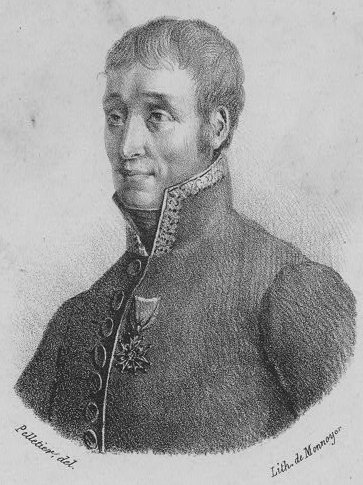Jean-Marie Coutelle on:
[Wikipedia]
[Google]
[Amazon]

 Jean-Marie-Joseph Coutelle (3 January 1748, in
Jean-Marie-Joseph Coutelle (3 January 1748, in

 Jean-Marie-Joseph Coutelle (3 January 1748, in
Jean-Marie-Joseph Coutelle (3 January 1748, in Le Mans
Le Mans (, ) is a city in northwestern France on the Sarthe River where it meets the Huisne. Traditionally the capital of the province of Maine, it is now the capital of the Sarthe department and the seat of the Roman Catholic diocese of Le Man ...
– 20 March 1835, in Paris
Paris () is the capital and most populous city of France, with an estimated population of 2,165,423 residents in 2019 in an area of more than 105 km² (41 sq mi), making it the 30th most densely populated city in the world in 2020. S ...
) was a French engineer, scientist and pioneer of ballooning.
Life
He got to know the physicist Alexandre Charles and, in the wake of the experiences of theMontgolfier brothers
The Montgolfier brothers – Joseph-Michel Montgolfier (; 26 August 1740 – 26 June 1810) and Jacques-Étienne Montgolfier (; 6 January 1745 – 2 August 1799) – were aviation pioneers, balloonists and paper manufacturers from the commune A ...
, Coutelle and Charles became interested in balloons. On 2 April 1794 the National Convention
The National Convention (french: link=no, Convention nationale) was the parliament of the Kingdom of France for one day and the French First Republic for the rest of its existence during the French Revolution, following the two-year National ...
made Coutelle a captain and first officer of the Company of Aeronauts and ordered him to build balloons to aid the French Revolutionary armies
The French Revolutionary Army (french: Armée révolutionnaire française) was the French land force that fought the French Revolutionary Wars from 1792 to 1804. These armies were characterised by their revolutionary fervour, their poor equipment ...
. In this role Coutelle was attached to the French invasion of Egypt
The French campaign in Egypt and Syria (1798–1801) was Napoleon Bonaparte's campaign in the Ottoman territories of Egypt and Syria, proclaimed to defend French trade interests, to establish scientific enterprise in the region. It was the ...
of 1798 under Napoleon Bonaparte
Napoleon Bonaparte ; it, Napoleone Bonaparte, ; co, Napulione Buonaparte. (born Napoleone Buonaparte; 15 August 1769 – 5 May 1821), later known by his regnal name Napoleon I, was a French military commander and political leader who ...
, but he was unable to function in this role in Egypt since the warship carrying his materials was severely damaged by fire during the Battle of the Nile
The Battle of the Nile (also known as the Battle of Aboukir Bay; french: Bataille d'Aboukir) was a major naval battle fought between the British Royal Navy and the Navy of the French Republic at Aboukir Bay on the Mediterranean coast off the ...
.
Instead he became one of the scholars of the Commission des Sciences et des Arts
The Commission des Sciences et des Arts (''Commission of the Sciences and Arts'') was a French scientific and artistic institute. Established on 16 March 1798, it consisted of 167 members, of which all but 16 joined Napoleon Bonaparte's conquest ...
. In November 1800 Coutelle and the mining engineer Rozière were authorised to accompany the great caravan of Tor, which was heading to Sinai
Sinai commonly refers to:
* Sinai Peninsula, Egypt
* Mount Sinai, a mountain in the Sinai Peninsula, Egypt
* Biblical Mount Sinai, the site in the Bible where Moses received the Law of God
Sinai may also refer to:
* Sinai, South Dakota, a place ...
with 1,800 camels. A member of the Costaz commission, he began to admire the two obelisks at Luxor
Luxor ( ar, الأقصر, al-ʾuqṣur, lit=the palaces) is a modern city in Upper (southern) Egypt which includes the site of the Ancient Egyptian city of ''Thebes''.
Luxor has frequently been characterized as the "world's greatest open-a ...
and suggested to the Institut d'Égypte
The Institut d'Égypte or Egyptian Scientific Institute is a learned society in Cairo specializing in Egyptology. It was established in 1798 by Napoleon Bonaparte to carry out research during his Egyptian campaign and is the oldest scientific inst ...
a new way of transporting one of them to France - 30 years later, a similar method to his suggestion was used to transport one to the Place de la Concorde
The Place de la Concorde () is one of the major public squares in Paris, France. Measuring in area, it is the largest square in the French capital. It is located in the city's eighth arrondissement, at the eastern end of the Champs-Élysées.
...
in Paris, where it now stands. Robert Solé, ''Les savants de Bonaparte'', Paris, Seuil, 1998,p. 130-131 He also used his ballooning expertise for Napoleon's planned invasion of Britain
The term Invasion of England may refer to the following planned or actual invasions of what is now modern England, successful or otherwise.
Pre-English Settlement of parts of Britain
* The 55 and 54 BC Caesar's invasions of Britain.
* The 43 AD ...
. He became a member of the Légion d’honneur on 17 January 1805, then a Chevalier de l’Empire on 28 June 1809. He died in 1835 and was buried in the 11th division of the cimetière du Père-Lachaise - his tomb was restored in 2004 by the " Souvenir français".
Notes
{{DEFAULTSORT:Coutelle 1748 births 1835 deaths Recipients of the Legion of Honour People from Le Mans Commission des Sciences et des Arts members French knights French balloonists 18th-century French engineers Burials at Père Lachaise Cemetery